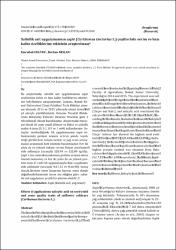| dc.contributor.author | Culpan, Emrullah | |
| dc.contributor.author | Arslan, Burhan | |
| dc.date.accessioned | 2022-05-11T14:45:33Z | |
| dc.date.available | 2022-05-11T14:45:33Z | |
| dc.date.issued | 2018 | |
| dc.identifier.issn | 2147-6403 | |
| dc.identifier.issn | 2618-5881 | |
| dc.identifier.uri | https://doi.org/10.29278/azd.476336 | |
| dc.identifier.uri | https://app.trdizin.gov.tr/makale/TXpjM05Ea3lNZz09 | |
| dc.identifier.uri | https://hdl.handle.net/20.500.11776/10079 | |
| dc.description.abstract | Bu araştırmada, salisilik asit uygulamasının aspirçeşitlerinin verim ve bazı kalite özelliklerine etkilerinin belirlenmesi amaçlanmıştır. Çalışma, Namık Kemal Üniversitesi Ziraat Fakültesi Tarla Bitkileri deneme alanında 2014 ve 2015 yıllarında olmak üzere ikiyıl süreyle yürütülmüştür. Deneme Tesadüf Bloklarında Bölünmüş Parseller Deneme Desenine göre 3tekrarlamalı olarak kurulmuştur. Araştırmada metaryal olarak iki aspir çeşidi (Dinçer ve Balcı) ve salisilikasidin 4 dozu (0, 0.1, 0.5 ve 1 mM) kullanılmıştır. Sonuçlar incelendiğinde SA uygulamasının aspir tohumlarında protein oranını artırıcı yönde teşvikettiği görülürken, tohum verimi ve yağ oranı ortalamaları arasındaki fark önemsiz bulunmuştur. Her ikiyılda da en yüksek tohum verimi Dinçer çeşidindenelde edilmiştir (sırasıyla 120.49 ve 122.89 kg/da).Çeşit x doz interaksiyonlarının protein oranına etkisiönemli bulunmuş ve her iki yılda da en yüksek protein oranı 0.1 mM SA uygulamasıyla Balcı çeşidindenelde edilmiştir (sırasıyla %17.15 ve %16.98). Sonuçolarak, protein oranı küspenin hayvan yemi olarakdeğerlendirilmesinde önem arz ettiğine göre, salisilik asit uygulaması pratik bir yöntem olabilir. | en_US |
| dc.description.abstract | The aim of this study was to determine effects of salicylic acid (SA) on yield and some quality components of safflower (Carthamus tinctorius L.). This research was conducted at Applying Research Field, Faculty of Agriculture, Namık Kemal University, Tekirdağ in 2014 and 2015. The experiment was laid out as a split plot design based on Randomized Complete Block Design with three replications, in which cultivars constituted the main plot with two cultivars (Dinçer and Balcı), and salicylic acid constituted the sub-plot with four doses (0, 0.1, 0.5 and 1 mM). According to the results, variation in doses of salicylic acid had a significant effect on protein content, but the differences between seed yield and oil content means was found not significant. Results show that Dinçer cultivar has showed the highest seed yield both 2014 and 2015 (120.49 and 122.89 kg/da respectively). In terms of protein content, the application of SA was found significant statistically and the highest protein content was obtained from Balcı cultivar with application of 0.1 mM SA in two years (%17.15 and %16.98 respectively). As a result, application of SA may be a practical method, because the protein content is important for the evaluation of the residue as animal feed. | en_US |
| dc.language.iso | tur | en_US |
| dc.identifier.doi | 10.29278/azd.476336 | |
| dc.rights | info:eu-repo/semantics/openAccess | en_US |
| dc.title | Salisilik asit uygulamasının aspir (Carthamus tinctorius L.) çeşitlerinin verim ve bazı kalite özelliklerine etkisinin araştırılması | en_US |
| dc.title.alternative | Effects of applications salicylic acid on seed yield and some quality traits of safflower cultivars (Carthamus tinctorius L.) | en_US |
| dc.type | article | en_US |
| dc.relation.ispartof | Akademik Ziraat Dergisi | en_US |
| dc.department | Fakülteler, Ziraat Fakültesi, Tarla Bitkileri Bölümü | en_US |
| dc.identifier.volume | 7 | en_US |
| dc.identifier.issue | 2 | en_US |
| dc.identifier.startpage | 173 | en_US |
| dc.identifier.endpage | 178 | en_US |
| dc.institutionauthor | Culpan, Emrullah | |
| dc.institutionauthor | Arslan, Burhan | |
| dc.identifier.trdizinid | TXpjM05Ea3lNZz09 | en_US |



















